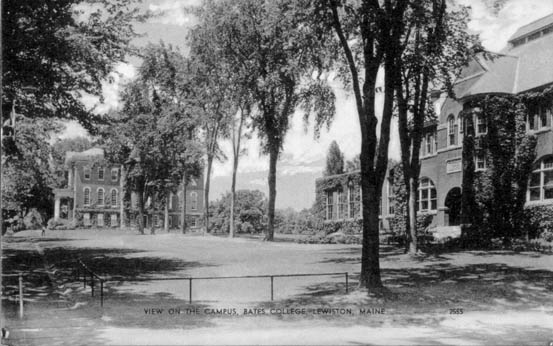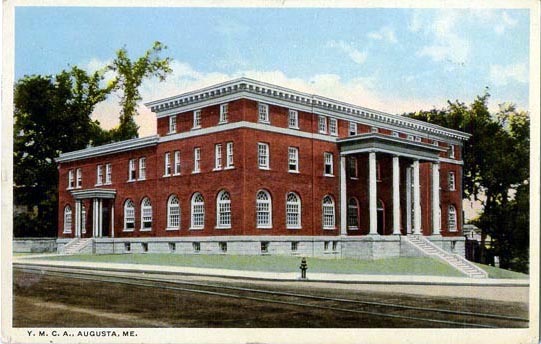Religious Societies
If you would like to add your Maine Religion resource to these pages please send an email to Tina Vickery. Good luck in your research!
Religion of the Indians. The Indian believed in the existence of the unseen world and of unseen beings by whom it was peopled, and with whom is priest could commune. These priests or medicine men performed the three-fold function of priest, prophet and physician. They held themselves to be kin to the mysterious powers to whose service they were devoted, and to be acceptable mediums of communication between them and the common people.
In common with other tribes of the Algoquin family, the Abenakis held that the world was under the influence of dual powers, beneficent and maleficent, and that there was one Great Spirit who held supreme rule, but at the same time did not interfere with these ever-conflicting powers. Upon this conception of deity their entire system of religious belief necessarily hinged; hence their belief in guardian sprits, which them denominated manitos.
They believed in a future existence, "they believed in the immortal soul and that it shall pass to the South-west Elysium, holding it to be a kind of paradise. For their enemies, who they account unworthy of this imaginary happiness, they say that they pass to the infernal dwellings of Abamocho, to be tortured according to the fictions of the ancient Heathen."
They believed in the duality of the soul, which is said to have been the reason for their custom of burying domestic utensils and other articles with the dead, and of placing food upon the graves. In common with many other races of mankind, they regarded the serpent as being the embodiment of the supernatural power, superior in wisdom and cunning -- in fact a manito which demanded their reverence.
First Services. The first Christian religious service conducted in Maine was in 1604 when the French under DeMonts visited Mount Desert. The first mass said in Maine was by Father Beard in October, 1611, on an island at the mouth of the Kennebec river. In 1607 the first Protestant religious service in New England was conducted by Rev. Richard Seymour at Popham, where a church was built. In 1646 Father Druillettes became a missionary to the Indians at Norridgewock. In 1688 Father Bigot erected a church at this place with was improved by the distinguished priest, Father Rale.
The Puritans did little to Christianize the Indians of Maine. Their one effort was confined to the mission at Arrowsic which lasted from 1717 to 1721.
English Church. For a brief period the English church was the state church in Maine under the charter given to Gorges in 1622. William Morrell, Richard Gibson and Robert Jordan, clergymen of the Church of England, tried to establish their church in Maine, but it failed and nothing further was attempted for eighty years. In 1770 the Episcopal church asked to be relieved from taxes of the Standing Order. Their petition was granted in 1772. A church was established in Gardiner in 1771. In 1880 there were two churches in Maine. The Episcopalians have grown constantly in influence and membership until today there are thirty-nine clergymen and 5656 communicants.
Puritan and Congregational. Thomas Farmer and John Wheelwright, Puritan ministers, preached at Saco and Wells for a brief time prior to 1647. In 1652 Massachusetts secured control of Maine and taxed the people for public worship. The minister was a town official. The first Puritan church was built in York in 1673.
 The Congregational church became the successor of the Pilgrims in religious work in Maine and founded Bowdoin College. Their missionary society was founded in 1807, and the Bangor Theological Seminary in 1814. They have continued from the first leaders of educational work, establishing many academies in the state. From this church have come many missionary, educational and civic leaders of great distinction. The Congregational church became the successor of the Pilgrims in religious work in Maine and founded Bowdoin College. Their missionary society was founded in 1807, and the Bangor Theological Seminary in 1814. They have continued from the first leaders of educational work, establishing many academies in the state. From this church have come many missionary, educational and civic leaders of great distinction.
Friends. The first Friends to visit Maine were Ann Coleman, Mary Tompkins and Alice Ambrose, who came to Berwick in 1662. A Friends Meeting House was established in Kittery in 1730, at Falmouth in 1743. Their work continued to prosper until by 1800 they had meeting places in all important towns. They have at the present time 23 meeting houses and about 1800 members.
Baptist. William Screven was ordained to the ministry in Boston in 1682 and attempted to establish a church in Kittery, but the established church caused his arrest, and he was fined and forbidden to preach. A century later Hezikiah Smouth founded the first Baptist Church in Maine and organized churches in Gorham (1768) and Berwick. The work prospered and an association of chuches was formed in Bowdoinham in 1787. A college was organized in Waterville in 1820. There are four Baptist preparatory schools, Hebron, Colburn, Higgins and Ricker. In 1867 the Baptist Convention was orgainized. The Baptist and Free Baptist churches became one church in 1915 under the presidency of Gov. Carl E. Milliken, a member of the Free Baptist church. They have 33,647 members and 400 churches.
Presbyterian. In 1734 William McClanethan, a Presbyterian minister, preached at Boothbay; McLane at Bristol at a later period, and in 1784 Whitaker was at Canaan and Williams at Winslow. The Presbyterian church continued to grow in membership and influence until 1800 when they were established in at least ten towns. After this period they declined and finally became Congregational churches. At the close of the seventeenth century there were 42 churches and 2186 members in Maine. At a later period there were three churches with 503 members.
Methodist. In 1793 Jesse Lee was sent by the New England Conference of the Methodist Episcopal Church to organize this church in Maine. He held the first services in Saco, Portland, Hallowell and Readfield in 1793. The Readfield circuit was organized, which included all of the state. A church was dedicated at Readfield in 1798 by Bishop Asbury; 1500 people were at the service. Maine has the distinction of giving to the Methodist Church Bishop Soule, who drafted the plan of the delegated General Conference, and also founded the Methodist Review. When Maine became a state in 1820, there were three districts, 27 circuits, 32 preachers and 6017 members. Academies have been established at Kents Hill and Bucksport. This church has through all the years contributed to the educational, social and political development of the state. She has continued to grow in influence and in membership. The total membership in 1919, including probationers, was 20,791.
Universalist. In 1802 Thomas Barnes preached in Norway, New Gloucester, Falmouth, Gray and severy other towns. Sylvanus Cobb of Norway organized the first church in Waterville in 1826. The Gospel Banner was established and published in Augusta and exerted a large influence. The first State Convention met in 1826. They have a fine academy at Westbrook. There are about 17,000 members.
 Free Baptist. Benjamin Randall of Berwick was the founder of the Free Baptist Church. He preached in New Hampshire and Maine, forming many churches, which were orgainized into a State Mission in 1834. The denomination continued to grow until it became one of the most influential in the state, having churches in all the cities. Its work for the rural districts has been among the greatest agencies for the uplift of people. This church established Bates College in Lewiston and the Maine Central Institute in Pittsfield. In 1915 the Free Baptist and the Baptist Churches united in one denomination, under the United Baptist Convention of Maine. Free Baptist. Benjamin Randall of Berwick was the founder of the Free Baptist Church. He preached in New Hampshire and Maine, forming many churches, which were orgainized into a State Mission in 1834. The denomination continued to grow until it became one of the most influential in the state, having churches in all the cities. Its work for the rural districts has been among the greatest agencies for the uplift of people. This church established Bates College in Lewiston and the Maine Central Institute in Pittsfield. In 1915 the Free Baptist and the Baptist Churches united in one denomination, under the United Baptist Convention of Maine.
Unitarian Church. The Unitarian Church was organized in Portland in 1791. Colonel Vaughn of Hallowell was for years the most distinguished Unitarian in America. Churches were founded in Bath and Waterville by Dr. Sheldon, at one time president of Colby College. The Unitarian churches in Maine were formed into an association at Saco in 1878. It now has 27 churches. The membership could not be ascertained.
Catholic Church. This church began its work with the coming of the first discoverers and had missions at Mount Desert and Norridgewock. When Maine became a state in 1820 there were few churches, the growth had been slow, but with the growth of lumbering and manufacturing the tide turned to this church. Soon, large and prosperous churches were located in all the large centers.
In 1853 the See of Maine and New Hampshire was instituted with 8 preists. In the early days they shared in the persecution that practically all churches faced in turn. Their priests were turned out of town, and their churches burned. In 1874 the Catholic population was 80,000 and they had 23 schools. St. Mary's College was established at Van Buren. In 1884 New Hampshire was withdrawn from the See of Maine. Under the brilliant leadership of Bishop Walsh, the efficiency of the church has been greatly increased. Remarkable advances have been made in church building, education and hospital work. There are today 131,638 Catholics in Maine, 143 priest, 47 parochial schools, 11 schools for girls, 1 college for boys, 7 orphan asylums and many other institutions.
Other Churches. There are many religious bodies in Maine that the student the progress must study if he would understand the development of the religious history of the state. They are Adventist, Seventh Day Advents, Disciples, Christians, New Jerusalem, Lutheran Church of God, Christian Science and Seventh Day Baptists.
Reform Societies.  The Maine Bible Society organized in 1809, distributes about 11,000 copies annually in fifty languages. The Maine Sunday School Society was organized in 1869. It represents 1200 schools with a membership of 100,000. The Christian Civic League was organized in March, 1897 in Waterville. The Christian Endeavor Society was found by Rev. Francis E. Clark at Portland, February 2, 1881. The Y. M. C. A. was organized at Portland, Nov. 9, 1853. The Maine Bible Society organized in 1809, distributes about 11,000 copies annually in fifty languages. The Maine Sunday School Society was organized in 1869. It represents 1200 schools with a membership of 100,000. The Christian Civic League was organized in March, 1897 in Waterville. The Christian Endeavor Society was found by Rev. Francis E. Clark at Portland, February 2, 1881. The Y. M. C. A. was organized at Portland, Nov. 9, 1853.
|